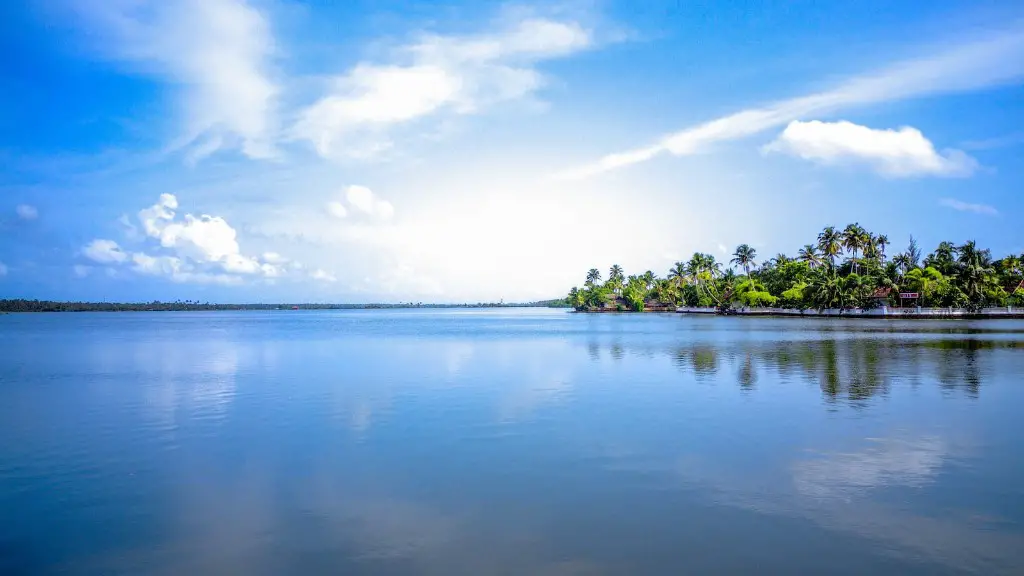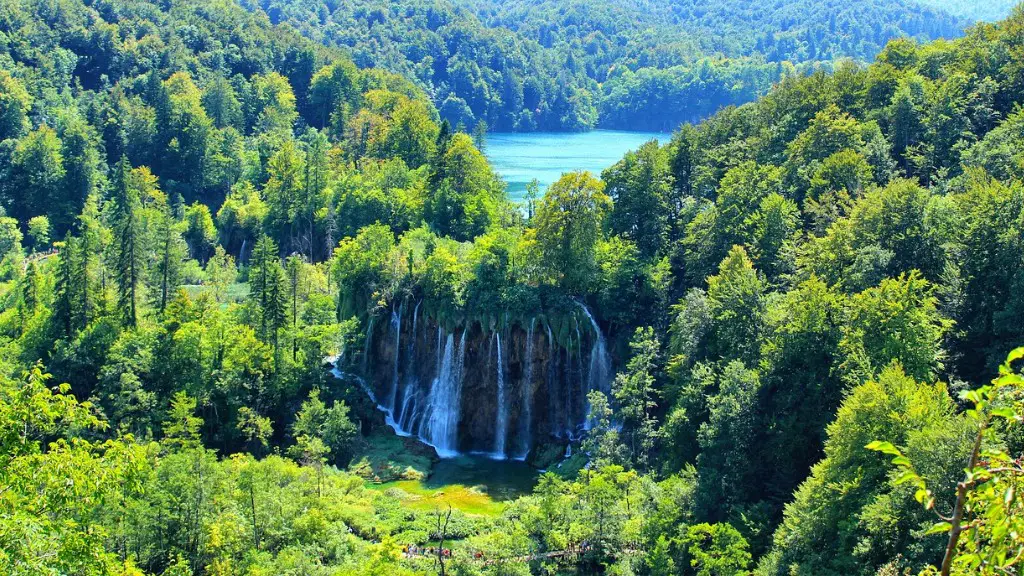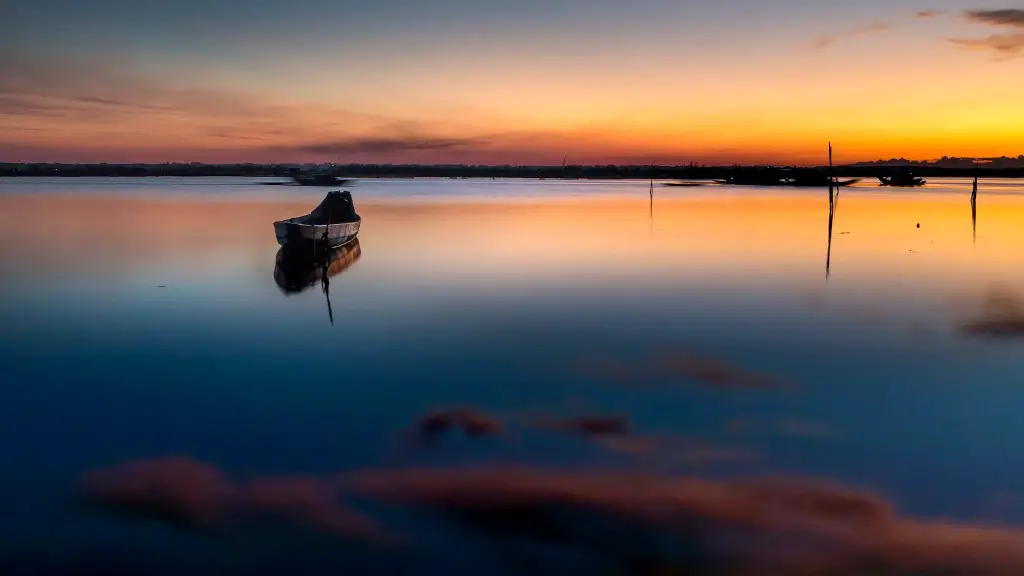Located in the Midwestern part of the United States, Lake Michigan is a large lake that is the fifth-largest in the world by surface area. It is bordered by four states – Wisconsin, Illinois, Michigan, and Indiana – and has an area of 22,404 square miles. As a result, it is not only the home to many people that live along its shores, but also a popular attraction for tourists and outdoor enthusiasts. But what makes Lake Michigan so blue?
The blue hue of Lake Michigan is due to the light being scattered by tiny particles in the water. These tiny particles, known as “suspended particulates,” are made up of dirt, algae, and organic matter. It is these particles that scatter light and give the lake its unique color. By capturing the blue wavelengths of the visible spectrum of light, these particles create a deep and vivid blue.
From a scientific perspective, experts attribute the blue color of Lake Michigan to the amount of calcium carbonate and other minerals that are present in it’s waters. These materials, known as “dissolved salts,” cause a refraction of light that results in the familiar deep blue color. Calcium carbonate in particular is especially important in the production of the blue hue since it has a stronger light-scattering effect than other minerals.
The vast amount of particles in the water is also a major factor in determining the color of Lake Michigan. The smaller the particles, the more light they are able to scatter and the brighter the blue. This includes the algae and other organisms that live in the lake, which influence how much light is scattered overall. As a result, the blue color of Lake Michigan can vary drastically depending on the amount of particulates in it at any given time.
Another reason why the lake may appear blue is due to its depth. At nearly 300 feet deep in some areas, the light is unable to penetrate the depths of the lake, making the blue color even more intense. On top of this, the vast size of Lake Michigan also contributes to its blue hue. The huge area of open water allows for more light to be scattered, resulting in an even brighter blue.
Finally, the way that the light reflects off of the lake also affects its color. With more sunlight and fewer clouds, the lake often appears to be an even brighter blue compared to days when the sky is cloudy. The sky’s reflection can also significantly change the color of the lake, making it look more green or brown depending on the time of day.
How Does Pollution Impact Lake Michigan?
Unfortunately, the presence of pollutants can also have an adverse effect on the color of Lake Michigan. With higher levels of phosphorus and nitrogen in the water, the amount of suspended particulates increases significantly. This increases the amount of light being scattered and can cause the water to take on an unnatural greenish hue. Industrial pollutants like heavy metals and other industrial waste can also cause the lake to take on a more murky color.
Naturally, this can have a damaging effect on the overall health of Lake Michigan. This, in turn, affects many of the animals, plants, and organisms that rely on the lake for their survival. Additionally, runoff from the surrounding lands can be a major source of pollutants, and can cause the lake to become unbalanced, affecting its overall oxygen levels and leading to depleted fish populations.
Furthermore, air pollution can also play a significant role in determining the color of the lake. With higher levels of nitrogen oxide and other pollutants, particulates can accumulate in the air and eventually settle onto the lake’s surface. This can obscure the lake’s clarity and reduce the amount of sunlight that is able to penetrate the lake’s depths, resulting in an even dimmer, murky blue.
With this in mind, it is essential that the surrounding communities do their best to protect the lake from further pollution. This includes reducing the amount of agricultural and industrial runoff, limiting air pollution, and increasing public awareness about the importance of protecting Lake Michigan. Without this, the lake’s pristine blue hue could soon become a distant memory.
Conclusion
Ultimately, Lake Michigan’s incredible blue hue is caused by the light’s scattering off of tiny particles in the water. Its unique color is a result of the calcium carbonate and other minerals present in its waters, as well as the shape, size, and depth of the lake. Unfortunately, the impact of pollutants can cause the lake to become murky and dull, affecting its clarity and the habitats of the organisms that rely on its waters.
Fortunately, with its ever-changing depth, shape and size, the blue hue of Lake Michigan is a constant reminder of its beauty. As long as the surrounding communities continue to protect the lake and reduce pollution, its breathtaking color will live on for generations to come.
The Effects Of Climate Change On Lake Michigan
As temperatures rise and weather patterns become more unpredictable due to climate change, the impacts on Lake Michigan are becoming increasingly evident. With higher temperatures and higher levels of precipitation, the amount of pollutants entering the lake from upstream sources is steadily increasing. This can have devastating consequences for the lake’s color and clarity.
At the same time, changes in evaporation rates and water currents can also significantly alter the temperature and composition of Lake Michigan. With warmer waters come higher levels of algae and other organic matter, which can further reduce the clarity of the lake and cause it to appear green. Warmer waters can also cause certain species of fish to become more prevalent, while others may struggle to survive due the water’s changing pH levels.
The impacts of climate change on Lake Michigan can also be seen in the changing ice cover of the lake. Ice cover is an important indicator of lake health as it helps to maintain proper oxygen levels and provides a platform for organisms to live on. However, as temperatures rise, ice cover is diminishing at a rapid pace, posing a further threat to the lake’s health.
Ultimately, it is essential that the public and private sectors work together to reduce the impacts of climate change on Lake Michigan. This includes limiting agricultural runoff, reducing air pollution, and increasing public awareness about the importance of protecting the lake. Only through taking these steps can we ensure that Lake Michigan remains the deep blue wonder that it is today.
Lake Michigan’s Impact On Local Wildlife
In addition to providing an unparalleled opportunity for recreation, Lake Michigan is a major part of the local ecosystem. Many species of fish, birds, mammals, and amphibians all call Lake Michigan home and rely on its waters for survival. As a result, changes to the lake’s color and clarity can have a substantial and widespread effect on the habitats of these species.
The biggest impact of Lake Michigan’s blue hue on local wildlife is that it helps to limit the amount of light that is available to certain species of fish. Many species of fish, such as herring and salmon, rely on darkness to survive and reproduce. The blue color of Lake Michigan helps to reduce the amount of light that penetrates its depths, providing the perfect habitat for these species to thrive.
The blue hue of Lake Michigan also helps to attract a variety of birds, mammals, and marine animals. This can be seen in the vast array of waterfowl that is attracted to the lake and the rare and endangered species of marine life that call its depths home. This rich and diverse ecosystem benefits not only the lake’s inhabitants, but also the surrounding communities.
With this in mind, it is essential that the public and private sectors work together to protect Lake Michigan. This includes reducing the levels of pollutants entering the lake from surrounding sources, limiting air pollution, and increasing public awareness about the importance of protecting the lake and its wildlife.
The Economic Impact Of Lake Michigan
Beyond its ecological importance, Lake Michigan is also a major economic force in the Midwest. As a major source of transportation, commerce, and recreation, the lake’s significance cannot be underestimated. From the jobs it provides to the businesses it attracts, Lake Michigan has a major impact on the local communities it serves.
The deep blue hue of Lake Michigan also provides an additional economic boost, as it serves as a major tourist attraction. With its stunning sunsets, vibrant blue color, and array of activities and attractions, tourists flock to the lake in droves every year. This could not only benefit the local economies, but also boost tourism to the entire Midwest region.
At the same time, the clarity of Lake Michigan can also impact the local economy. With higher levels of clarity comes increased visibility, which can make it easier for commercial vessels to safely traverse its waters. This can lead to increased activity on the lake, larger vessels, and more efficient operations, all of which can provide a tremendous economic benefit.
Overall, the economic impact of Lake Michigan is immense. With its deep blue hue and stunning visibility, the lake provides a major source of transportation, commerce, and recreation that is essential to the economic prosperity of the surrounding communities. This is why it is essential that the public and private sectors work together to protect the lake from further environmental damage.





